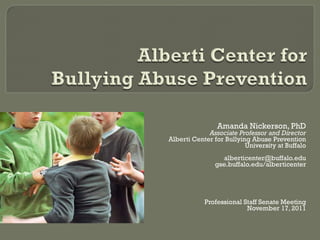
Alberti Center for Bullying Abuse Prevention
- 1. Amanda Nickerson, PhD Associate Professor and Director Alberti Center for Bullying Abuse Prevention University at Buffalo alberticenter@buffalo.edu gse.buffalo.edu/alberticenter Professional Staff Senate Meeting November 17, 2011
- 2. Alberti Center Slideshow About the Alberti Center Brief Overview of Bullying Resources for Students
- 4. Our mission is to research, identify, and disseminate resources to practitioners on the topics of bullying abuse prevention and intervention.
- 5. Jean M. Alberti, Amanda B. Nickerson, Ph.D. Rebecca E. Ligman, M.S.Ed. Ph.D. Director Assistant to the Director Benefactor Heather Cosgrove Michelle Serwacki Graduate Assistant Graduate Assistant
- 6. Identification of high quality resources and links for website Needs assessment • Resource availability and utilization Selectpresentations to educators, parents, and community organizations
- 7. Gender, empathy, group norms, and prosocial affiliations on bullying roles (middle school) Bullying, anxiety, and self-care (middle school) Group intervention for students at-risk for depression (middle and high school) Evaluation of the PREPaRE School Crisis Prevention and Intervention Training Curriculum
- 8. Protectivefactors (focus on family) for bullying, victimization and sexual harassment Assessment and ongoing monitoring of school climate and bullying/victimization (in conjunction with examination of strategies implemented) Spring 2012 bullying prevention conference
- 9. Bullying, Cyberbullying, and Youth Depression: A Parent Perspective A presentation by John Halligan November 21, 2011 7:00 – 8:30 p.m. Wesleyan Church of Hamburg www.frontier.wnyric.org/frontier/lib/frontier/Dignity_for_All.pdf Parents: Learn More About Bullying & Prevention Skills to Help Your Children A UB Employee Assistance Program workshop led by Dr. Amanda Nickerson December 13, 2011 10:00 a.m. – 12:00 p.m. 120 Clemens Hall, UB North Campus hr.buffalo.edu/index.php?module=pagemaster&PAGE_use_op=view_page&PAGE_id=747
- 11. Intentional, usually repeated acts of verbal, physical, or written aggression by a peer (or group of peers) operating from a position of strength or power with the goal of hurting the victim physically or damaging status and/or social reputation Olweus (1978); United States Department of Education (1998)
- 12. Physical bullying • punching, shoving, acts that hurt people Verbal bullying • name calling, making offensive remarks Indirect bullying • spreading rumors, excluding, ganging up Cyber bullying • willful and repeated harm inflicted through the use of computers, cell phones, and other electronic devices Hinduja & Patchin (2009)
- 13. Bullying: Based on a power imbalance; intent to cause psychological or physical harm; usually repeated Teasing: Fun, good-natured, “give-and-take” between friends to get both parties to laugh Conflict: A struggle, dispute, or misunderstanding between two equal forces
- 14. STRUCTURE and SUPPORT • Clear, consistently enforced expectations and policies for behavior, including prohibition of bullying and harassment, and effective classroom management – means of reporting • Warmth, positive interest, adult involvement and supervision, and appreciation of differences
- 15. Briefassemblies or one-day awareness raising events Zero-tolerance policies • May result in under-reporting bullying • Limited evidence in curbing bullying behavior Peer mediation, peer-led conflict resolution • Many programs that use this approach actually saw increase in victimization • Grouping students who bully together may actually reinforce this behavior Dodge, Dishion, & Lansford, (2006); Farrington & Ttofi, (2009); Nansel et al., (2001)
- 16. Listen Empathize • “That must have been very scary for you” Thank student for telling Take is seriously Partner with student and school to problem-solve Follow-up
- 17. Focus on behavior (not student as person) and why it is not OK Apply logical, meaningful consequences Increase supervision and monitoring Work with student to develop plan for how to prevent this behavior in the future Consider professional help to increase empathy, perspective taking, and problem-solving
- 18. Prohibits harassment of students with respect to race, weight, religion, sexual preference, etc. Unlawful to not remedy harassment or bullying on school grounds Includes: • Policies and guidelines • Curriculum changes in civility, citizenship, and character www.p12.nysed.gov/dignityact/ education Effective July 1, 2012 • Training (for staff and point person) • Record keeping
- 20. University Police – 716.645.2222 (if there is an imminent threat) Office of Judicial Affairs – 716.645.6154 (if there is not an imminent threat) Counseling Center – 716.645.2720 (for counseling services) Officeof Equality, Diversity & Affirmative Action – 716.645.2266 (for sexual harassment concerns)
- 21. SuicideLifeline 1.800.273.TALK LGBTQ Youth Suicide Hotline 1.866.4.U.TREVOR Crisis Services Hotline 716.834.3131 Crisis Chat www.crisischat.org (online emotional support)
